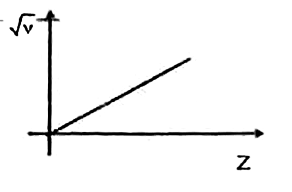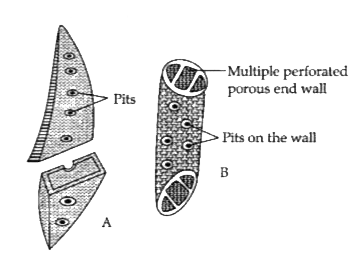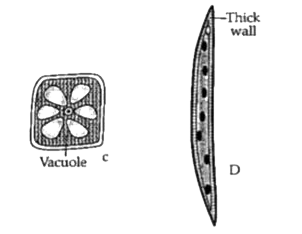Draw and identify different elements of phloem.
Step-by-Step Solution:
1. Understanding Phloem:
- Phloem is a type of vascular tissue in plants responsible for the transport of food, particularly sugars, from one part of the plant to another. It is classified as a complex tissue because it consists of different types of cells.
2. Identifying the Components of Phloem:
- Phloem is made up of four main types of cells:
- Sieve Tube Elements: These are elongated cells that form the main conducting pathway for sugars. They are arranged end to end, forming long tubes.
- Companion Cells: These cells are closely associated with sieve tube elements. They have a nucleus and help regulate the activities of the sieve tube elements.
- Phloem Parenchyma: These are living cells that serve as storage and support. They are loosely arranged and provide structural support to the phloem.
- Phloem Fibers: These are thick-walled cells that provide mechanical support and strength to the phloem tissue.
3. Drawing the Phloem:
- Start by drawing a long, tubular structure to represent the sieve tubes.
- Add small circles or ovals along the sides to represent the companion cells.
- Include some compactly arranged cells to depict phloem parenchyma.
- Draw some elongated, thick-walled cells to represent phloem fibers.
4. Labeling the Diagram:
- Clearly label each component of the phloem in your drawing:
- Sieve Tube Elements
- Companion Cells
- Phloem Parenchyma
- Phloem Fibers
5. Finalizing the Diagram:
- Ensure that your drawing is neat and all components are easily identifiable.
- Use arrows or lines to connect the labels to the respective parts of the drawing.
- Phloem is a type of vascular tissue in plants responsible for the transport of food, particularly sugars, from one part of the plant to another. It is classified as a complex tissue because it consists of different types of cells.
- Phloem is made up of four main types of cells:
- Sieve Tube Elements: These are elongated cells that form the main conducting pathway for sugars. They are arranged end to end, forming long tubes.
- Companion Cells: These cells are closely associated with sieve tube elements. They have a nucleus and help regulate the activities of the sieve tube elements.
- Phloem Parenchyma: These are living cells that serve as storage and support. They are loosely arranged and provide structural support to the phloem.
- Phloem Fibers: These are thick-walled cells that provide mechanical support and strength to the phloem tissue.
- Start by drawing a long, tubular structure to represent the sieve tubes.
- Add small circles or ovals along the sides to represent the companion cells.
- Include some compactly arranged cells to depict phloem parenchyma.
- Draw some elongated, thick-walled cells to represent phloem fibers.
- Clearly label each component of the phloem in your drawing:
- Sieve Tube Elements
- Companion Cells
- Phloem Parenchyma
- Phloem Fibers
- Ensure that your drawing is neat and all components are easily identifiable.
- Use arrows or lines to connect the labels to the respective parts of the drawing.
Topper's Solved these Questions
- BOOK - NCERT EXEMPLAR ENGLISHCHAPTER - TISSUESEXERCISE - Fill in the blanks2videos
TISSUES
- BOOK - NCERT EXEMPLAR ENGLISHCHAPTER - TISSUESEXERCISE - Long answer9videos
TISSUES
- BOOK - NCERT EXEMPLAR ENGLISHCHAPTER - TISSUESEXERCISE - Match the following3videos
TISSUES
- BOOK - NCERT EXEMPLAR ENGLISHCHAPTER - THE FUNDAMENTAL UNIT OF LIFE EXERCISE - Long Answer Type Questions7videos
THE FUNDAMENTAL UNIT OF LIFE
- BOOK - NCERT EXEMPLAR ENGLISHCHAPTER - WHY DO WE FALL ILL EXERCISE - Long Answer Type Questions10videos
WHY DO WE FALL ILL
Similar Questions
Knowledge Check
- Question 1 - Select One
Identify the element of price mix.
AList priceBDiscountsCSeasonal pricingDAll of the above
Draw a standard ECG and explain the different segments in it.
View Solution
Moseley was able to arrange the different elementsView SolutionGiven below are compounds of xylem and phloem. Study the same and answer the questions given below :


Draw a neat, labelled diagram of a phloem.View SolutionAtomic number of few elements are given below 10, 20, 7, 14
(a) Identify the elements
(b) Identify the group number of these elements in the periodic table
(c) Identify the periods of these elements in the periodic table
(d) What would be the electronic configuration for each of these elements
(e) Determine the valency of these elements.View SolutionThe movement of water and minerals in xylem and the movement of phloem sap in phloem is respectively
View Solutionoldest phloem is
View SolutionWhat are the constituents of phloem?
View Solution

